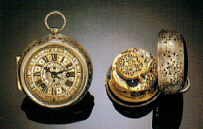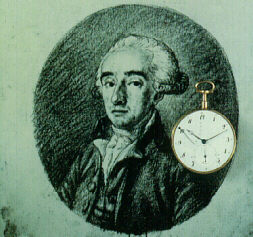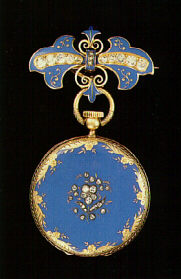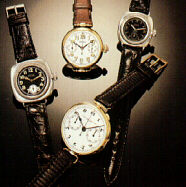
 |
 |
| Watches dating from (clockwise from top) circa 1730, 1700, 1630, 1790 and 1700. All were made in Switzerland or Germany, and offered for sale in 1993 by the Geneva Auction House, Antiquorium. |
So goes one version of the birth of watch-making. It has never been confirmed, and, like much watch history that followed, is the subject of some dispute.
Ovoid or otherwise, from Nuremberg or somewhere else, the first watches- and all their descendants up to the middle of this century depended on a simple but ingenious invention. It was a spring that, as it gradually unwound, provided energy that moved the timepiece hands, thus performing the same function as the weights that powered the clock atop the village church tower. This device came to be known as the mainspring.
The earliest watches were ornate, exorbitantly expensive contraptions that contributed more to their wearers' social status than to their punctuality. They had no minutes hands, which would have been pointless on timepieces that could barely register the correct hour. Furthermore, they were a royal nuisance (and royalty were just about the only people who could afford them), needing to be wound with a key twice a day. People wore them around their necks or carried them in purses. (Elizabeth I of England, who lived from 1533 to 1603, reportedly bucked convention when it came to watches as she did in much else. She is said to have worn a "ring" watch that alerted her to the arrival of a pre-set hour by scratching her finger with a metal projection.)
Accuracy improved gradually through the 16th and first part of the 17th centuries. Then, around 1675, it made a quantum leap due to the second great invention in watch history, the "balance" or "hair" spring. The balance spring was an unprecedentedly precise way of regulating the oscillations of the balance. Most historians give credit for the invention to Christiaan Huygens of Holland. The balance spring made watches accurate to within an amazing 5 minutes a day. There would not be a comparable leap in watch accuracy until the first electronic watch, Bvlova's Accutron (developed by the Swiss electrical engineer Max Hetzel), appeared in 1960.
 |
 Top: A watch by London clock and watchmaker Thomas Tompoin, circa 1690. It was offered for sale by the auction house antiquorium in 1993. Right: Christiaan Huygens Top: A watch by London clock and watchmaker Thomas Tompoin, circa 1690. It was offered for sale by the auction house antiquorium in 1993. Right: Christiaan Huygens |
 |
 Above: The Count of Castellane (1758-1837) with his Breguet watch. It brought 300,000 Swiss francs, or about $215,000, when it was auctioned off in 1991. Above: The Count of Castellane (1758-1837) with his Breguet watch. It brought 300,000 Swiss francs, or about $215,000, when it was auctioned off in 1991.Right:Abraham-Louis Breguet |
Timekeeping improvements followed quickly during the century that followed. The first watches with a seconds hand appeared in the 1690s. The first chronograph, consisting of a seconds hand which could be stopped independently while the watch itself kept running, appeared in 1776.
One of the biggest events of the era, though, wasn't the birth of an idea, but of an idea man. Abraham-Louis Breguet (1747-1823), just about everyone agrees, was the greatest watchmaker of all time.
Born in Neuchatel, Switzerland, he spent most of his life working in Paris, where he became the watch and clockmaking darling of the ancient regime before the French Revolution. When the conflict was over, he made amends with the victors and they, too, became his customers. He was watchmaker to European royalty and U.S. presidents (George Washington owned a Breguet. So did Alexander I. Marie Antoinette owned many, Napoleon and Josephine Bonaparte were avid customers, as were other Bonaparte family members.) Everyone wanted, to paraphrase an English baronet, writing a century after Breguet's death, "to hold the brains of a genius in [his] pocket."
Among Breguet's inventions was the tourbillon, which compensates for the slight differences in timing a watch records when held in different positions. The tourbillon remains a much-coveted feature on expensive mechanical watches today. He also invented a watch that ran without winding for 60 hours. The perpetual calendar, so named because it automatically adjusts for the number of days in the month and for leap years, was another Breguet invention. It, like the tourbillon, is a sought-after feature on modern watches.
Thanks to a shockproofing device Breguet developed, the timepieces made in his 100-man workshop were more durable and reliable than any had been before. (The nearly 300 years that had passed since the Nuremberg eggs, whose fragility made the name doubly apt, had done little to make watches sturdier.) They also looked completely different from the elaborately decorated rococo styles that had been in vogue. Breguet's watches had slim, graceful cases and simple faces. An engraving process called "engine turning," yet another Breguet invention, gave the dials a rich, satiny finish. Even the watches' hands were stand-outs, bearing elegantly tapered tips embellished, for greater visibility, with small open circles. Watch designers today still use "Breguet" hands to impart a look of elegance.
Breguet's life bridged two eras in watch history. The first was one of hand craftsmanship catering to the wealthy few, an age Breguet epitomized with his exquisite, custom-made pieces. The second, already underway when Breguet died, would be increasingly dominated by mass production and mass demand, the hallmarks of the industrial Revolution.
The swelling urban population needed watches to keep the machinery of the burgeoning factories, and of city life in general, running smoothly. In 1825 came a dramatic event that accelerated the growth in demand for watches: The world's first steam-operated freight and passenger railroad went into operation in England. Rail transport soon spread throughout Europe and America, and with it a need for portable timepieces.
The railway, in turn, led to the institution of standard time zones, first in the U.S. (in 1883) and then throughout the world. (Prior to that, there were nearly 300 local times in this country alone.) That made watches all the more desirable, since they now told the wearer not just the time at home but everywhere else in the world. World watch production increased by nearly 10 times to 2.5 million between 1800 and 1875.
About two-thirds of those watches were made in Switzerland, which in the late 18th century unseated England as king of the watchmaking world.
In the 19th century came the introduction of standardized, machine made parts in watch factories in Switzerland and the United States. The American company Waltham Watch Co. was an early pioneer of machine production. it and other U.S. companies produced timepieces of unsurpassed quality, and were the reason for America's brief shining moment in watch history in the latter half of the l9th century. For a few years, American watchmaking was the envy of the expert Swiss.
It was the latter, though, who prevailed. Good as the Americans were at mastering machine production, the Swiss were better, with more versatile factories making a broader range of watches.
At the same time, the Swiss industry had honed its hand-crafting skills to their sharpest point ever. Companies such as Patek Philippe made lavish one-of-a-kind pieces for the rich and famous, including Enoand's Queen Victoria and Prince Albert and other crowned heads of Europe.
 Above: A watch made by Patek Philippe for Queen Victoria of England | |
 |  |
| Above: Patek Philippe founders Adrien Philippe and Antoine Norbert de Patek | |
A new century brought a new type of timer. Well, almost new. The first wristwatches were probably worn in the early 19th century (although at least one expert claims Elizabeth I wore a little watch tied around her wrist with a ribbon, a companion, presumably, to her finger-scratching "ring" watch). in 1906, Cartier made a wristwatch for the aviator Alberto Santos-Dumont, who had requested a timepiece that would allow him to keep his hands free while flying his airships. In 1911 the company started producing the "Santos-Dumont" wristwatch for European high society, making it the first truly commercial wristwatch.
But it was not until World War I, when the military surrendered en masse to the charms of fumble-free time-telling, that wristwatches were taken up by the general public.
Somewhat reluctantly, as it turned out. Despite their blood-and-guts birth in the trenches, wristwatches were at first dismissed by many as uncomfortably unmasculine. Men and women alike often thought of them as a fad.
Within a decade most had changed their minds. By the late 1920s world production of wristwatches had surpassed that of pocket watches. The wristwatch's appeal was not just convenience, but appearance. The new timers quickly developed a personality of their own, taking on shapes never imagined in the days of the pocket watch-tonneau, square (like the SantosDumont), baguette and tank- and decorated with a fanciful assortment of numerals, lugs and bracelets.
Switzerland remained the leader in watch production as Patek Philippe, Constantin, Audemars Piguet and scores of others converted their factories to wristwatch production.
As the decades passed, Swiss manufacturers set about miniaturizing for wristwatches all the
 Three Rolex wristwatches from (left to right) the 1920s, circa 1915, and the 1930s, and a Vacheron Constantin (bottom of photo) from the 1910s. |
They also made their watches increasingly accurate. just how accurate became apparent when, in 1962, NASA bought from a Houston jewelry store an Omega Speedmaster, subjected it to a battery of hellish endurance and accuracy tests, and found it fit to fly in a spaceship around the world, and eventually much farther. On July 20, 1969, when Apollo 11 made its historic lunar landing, the Speedmaster became the first watch on the moon.
But the Swiss Apollo triumph was short-lived. Within a few months watch technology would make a leap as giant as Armstrong's. It would take place not in Switzerland, but in Japan.